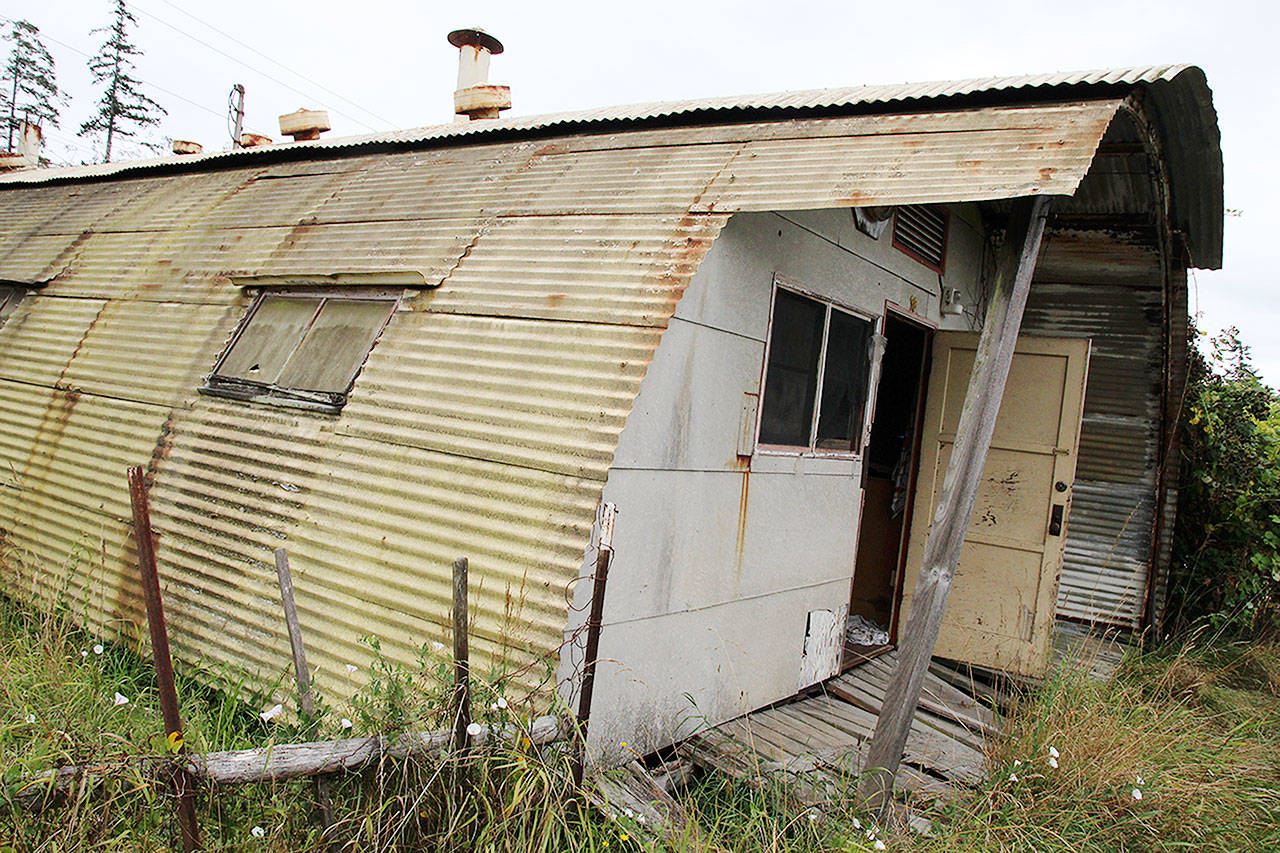A hidden relic of the World War II-era solution to “Oak Harbor’s first housing crisis” is in danger, and members of the PBY Memorial Foundation are scrambling to save it.
An old Quonset hut stands, covered from view by blackberry bushes, off of State Highway 20, just south of city limits. The run-down metal structure may not look special, but researchers from the PBY Naval Air Museum have discovered it is one of the last remaining units in the original configuration from the Navy Homoja housing program, which began in 1943.
“It took several trips and a lot of research, but we confirmed that it was, in fact, a Homoja hut,” said Wil Shellenberger, president of the PBY Memorial Foundation.
AS FAR as researchers know, it may be the only one remaining, Shellenberger said.
The problem is, the foundation needs about $30,000 to move it off the property and there’s only about a month to raise funds. All of the structures on the land are to be demolished in October. The owner of the hut donated it to the foundation, now the “real challenge” lies ahead, Shellenberger said.
Engineers from the building moving company Nickel Bros have confirmed the structure is sound enough to be moved, but the 2018 budget for the museum foundation is set and it doesn’t include an extra $30,000.
NORMALLY, THERE would be grant money available for this kind of project, but there isn’t enough time to go through the eight- or nine-month process of getting approved, Shellenberger said.
“That’s why we’re going directly to the community,” he said.
The foundation is asking businesses, nonprofits and individuals for donations to come up with the money needed to move the historic hut. The hope is to restore it to how it looked when it was being used as housing from the early 1940s to mid 1960s, and turn it into a museum exhibit.
OAK HARBOR resident Scott Hornung said he “took two tours in the Quonset huts” as a child. He and his family lived in Homoja housing in March 1957 and December 1960.
The Homoja program got its name from the admirals involved in its inception, whose last names were Horne, Moreel and Jacobs. The secretary of the Navy approved construction of the first 1,000 units of the program on Sept. 27, 1943.
The 20-by-49-foot Quonset shells were divided in two, and each section included two bedrooms, a kitchen area, a bathroom and a living area.
“I remember the smell,” said Hornung, which he described as of linoleum and the oil burning stove. He celebrated his 12th birthday and Christmas in the Quonset hut in 1960.
His mother put in a cardboard fireplace as decoration, he said.
THE UNITS were typically only used for a month or two so that sailor’s families had a place to stay while the servicemen went through training between deployments, Shellenberger said.
When the base was established in Oak Harbor, the city went from a population of 350 to nearly 10,000. This time period is what Shellenberger refers to as the city’s “first housing crisis.”
Some of the families lived in the huts until houses were ready for them to move into, which was the case for Hornung’s family in 1960.
THE HOMOJA program was most active during the war, with the Navy completing over 6,200 units across the United States at a total cost of $21.1 million between 1943 and V-J Day in 1945. In Oak Harbor, the structures were sold off and re-purposed.
Oak Harbor City Councilman Jim Woessner said he attended kindergarten classes in a converted Homoja hut in the mid 1960s.
Each hut had two classrooms with kitchen areas and two bathrooms, Woessner said.
Former Oak Harbor mayor and veterinarian Doc Ellis used one as his first vet office, Shellenberger said. Others were used on farms for storage, and the one the foundation is trying to save was used by a local Boy Scout troop.
In addition to funds for saving the hut, Shellenberger said he’s looking for more stories from locals who lived in Homoja units.
If the hut can be saved, he said the foundation wants the exhibit to portray “Oak Harbor as home for servicemen.”
THOUGH THEY served as temporary homes, the lightweight steel structures weren’t the most comfortable living quarters.
“I don’t have fond memories of living in the Quonset,” said Hornung with a laugh. “I think I was glad to get out of them.”
• Those who want to donate to the rescue effort can send a check, marked for the Homoja Hut Program, to PBY Naval Air Museum, P.O. Box 941, Oak Harbor, WA.



